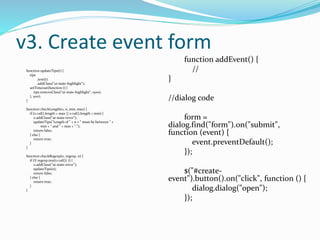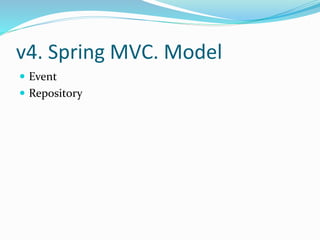Ad
Google app engine by example
- 1. Google App Engine by example
- 2. About me Linked[in]: ua.linkedin.com/in/invaa/ e-mail: [email protected]
- 3. Google App Engine PaaS 264k websites (258k is active) URL: http://trends.builtwith.com/hosting/Google-App- Engine Coca-cola, Ubisoft, Rovio, BestBuy, Sony Music, ... URL: https://cloud.google.com/customers/
- 4. Demo Tic Tac Toe using Google Endpoints Features: API Web frontend Android client Deployed: https://cloudendpointstic.appspot.com Sources: https://github.com/GoogleCloudPlatform
- 5. Plan Get to know the Google App Engine (GAE) while making a simple jQuery Calendar (aka “Google Calendar killer”) and put the app in the Google Cloud.
- 7. Calendar app Events with persistence in the Google Cloud Start End Title Description Color Attenders Add events Move events
- 8. Requirements and Prerequisites JDK 1.7 (recommended) Apache Maven 3.1+ MySQL 5+ (for local dev server) Google account Application ID IDE More: https://cloud.google.com/appengine/docs/java/gettingstarte d/setup
- 9. TODO V1: Project creation and structure V2: Spring MVC V3: View with jQuery Calendar V4: Persistence with Cloud SQL V5: Persistence with Cloud Datastore V6: Attenders and colors V7: update events on drop More: https://github.com/invaa/CloudCalendar
- 10. Cloud Calendar Service v1 Create project structure Run locally
- 11. v1. Getting application ID URL: https://appengine.google.com/start
- 12. v1. Project creation mvn archetype:generate -Dappengine-version=1.9.13 - Dapplication-id=your-app-id - Dfilter=com.google.appengine.archetypes: Google Cloud Console
- 13. v1. Project structure You'll add your own application Java classes to src/main/java/... You'll configure your application using the file src/main/webapp/WEB-INF/ appengine.web.xml You'll configure your application deployment using the file src/main/webapp/WEB-INF/ web.xml
- 14. v1. Dependencies. Template appengine-api-1.0-sdk servlet-api Jstl appengine-testing appengine-api-stubs
- 15. The Java Development Server jetty-6.1.x (built-in) The development web server simulates the App Engine Java runtime environment and all of its services, including the datastore More: https://cloud.google.com/appengine/docs/java/tools/ devserver
- 16. Admin console http://localhost:port/_ah/admin
- 17. Cloud Calendar Service v2 Spring MVC Calendar controller getPages() and “/” mapping Upload Calendar to GAE
- 18. v2. Dependencies. Spring MVC <dependency> <groupId>org.springframework</groupId> <artifactId>spring-webmvc</artifactId> <version>${spring.version}</version> </dependency>
- 19. v2. Spring MVC. Controller getPages() and “/”
- 20. v2. Uploading App mvn appengine:update More: https://cloud.google.com/appengine/docs/java/tools/ uploadinganapp
- 21. Dev Console https://console.developers.google.com/
- 24. Appcfg appengine-java-sdkbinappcfg.cmd [options] <action> <war-location> More: https://cloud.google.com/appengine/docs/java/tools/ uploadinganapp?hl=ru#Uploading_the_App
- 25. Cloud Calendar Service v3 Button jQuery Calendar Upload Calendar to GAE
- 26. v3. Spring MVC. View <link rel="stylesheet" href="http://fullcalendar.io/js/fullcalendar- 2.1.1/fullcalendar.min.css"> <link rel="stylesheet" href="http://code.jquery.com/ui/1.11.1/themes/smoothness/jquer y-ui.css"> <script src="http://code.jquery.com/jquery- 1.10.2.min.js"></script> <script src="http://code.jquery.com/ui/1.11.1/jquery-ui. min.js"></script> <script src="http://fullcalendar.io/js/fullcalendar- 2.1.1/lib/moment.min.js"></script> <script src="http://fullcalendar.io/js/fullcalendar- 2.1.1/fullcalendar.min.js"></script>
- 27. v3. Spring MVC. View body { margin: 0; padding: 0; font-family: "Lucida Grande", Helvetica, Arial, Verdana, sans-serif; font-size: 14px; } #script-warning { display: none; background: #eee; border-bottom: 1px solid #ddd; padding: 0 10px; line-height: 40px; text-align: center; font-weight: bold; font-size: 12px; color: red; } #calendar, #container { max-width: 900px; margin: 40px auto; padding: 0 10px; }
- 28. v3. Create event form label, input { display: block; } input.text { margin-bottom: 12px; width: 95%; padding: .4em; } fieldset { padding: 0; border: 0; margin-top: 25px; } div#users-contain { width: 350px; margin: 20px 0; } div#users-contain table { margin: 1em 0; border-collapse: collapse; width: 100%; } div#users-contain table td, div#users-contain table th { border: 1px solid #eee; padding: .6em 10px; text-align: left; } .ui-dialog .ui-state-error { padding: .3em; } .validateTips { border: 1px solid transparent; padding: 0.3em; }
- 29. v3. Create event form function updateTips(t) { tips .text(t) .addClass("ui-state-highlight"); setTimeout(function () { tips.removeClass("ui-state-highlight", 1500); }, 500); } function checkLength(o, n, min, max) { if (o.val().length > max || o.val().length < min) { o.addClass("ui-state-error"); updateTips("Length of " + n + " must be between " + min + " and " + max + "."); return false; } else { return true; } } function checkRegexp(o, regexp, n) { if (!( regexp.test(o.val()) )) { o.addClass("ui-state-error"); updateTips(n); return false; } else { return true; } } function addEvent() { // } //dialog code form = dialog.find("form").on("submit", function (event) { event.preventDefault(); }); $("#create-event"). button().on("click", function () { dialog.dialog("open"); });
- 30. Add some persistency I am CRUD!
- 32. Cloud Calendar Service v4 Model Persistence
- 33. v4. Cloud SQL Spring Data EclipseLink JPA Provider
- 34. v4. Cloud SQL. Dependencies <dependency> <groupId>mysql</groupId> <artifactId>mysql-connector-java</ artifactId> <version>5.1.25</version> </dependency> <dependency> <groupId>org.eclipse.persistence</groupId> <artifactId>org.eclipse.persistence.jpa</artifactId > <version>2.4.2</version> </dependency> <dependency> <groupId>org.springframework.data</groupId> <artifactId>spring-data-jpa</artifactId> <version>${spring.data.version}</version> </dependency> <dependency> <groupId>com.fasterxml.jackson.core< /groupId> <artifactId>jackson-databind</ artifactId> <version>2.3.2</version> </dependency>
- 35. v4. Cloud SQL. Context <persistence-unit name="jpa.unit"> <provider>org.eclipse.persistence.jpa.PersistenceProvider</ provider> <class>com.calendar.service.model.Event</class> <exclude-unlisted-classes>true</exclude-unlisted-classes> <properties> <property name="eclipselink.jdbc.url" value="jdbc:mysql://127.0.0.1:3306/demo"/> <property name="eclipselink.jdbc.driver" value="com.mysql.jdbc.Driver"/> <!-- Production --> <!--<property name="eclipselink.jdbc.driver" value="com.mysql.jdbc.GoogleDriver" />--> <!--<property name="eclipselink.jdbc.url" value="jdbc:google:mysql://your-instance-name/ demo?user=root" />--> <property name="eclipselink.jdbc.user" value="root"/> <property name="eclipselink.jdbc.password" value=""/> </properties> </persistence-unit> <bean id="entityManagerFactory" class="org.springframework.orm.jpa.LocalContainerEntityMa nagerFactoryBean"> <property name="persistenceUnitName" value="jpa.unit" /> <property name="jpaVendorAdapter"> <bean class="org.springframework.orm.jpa.vendor.EclipseLinkJpaVe ndorAdapter"> <property name="showSql" value="true"/> <property name="generateDdl" value="true"/> <property name="databasePlatform" value="org.eclipse.persistence.platform.database.MySQLPlatf orm"/> </bean> </property> <property name="jpaPropertyMap"> <props> <prop key="eclipselink.weaving">false</prop> </props> </property> </bean>
- 36. v4. Cloud SQL. Other @Temporal(TemporalType.TIMESTAMP) <use-google-connector-j>true</use-google-connector- j>
- 37. v4. Spring MVC. Model Event Repository
- 38. v4. Cloud SQL. Deployment Create DB (dev vs production) More: https://code.google.com/apis/console/b/0/?noredirect &pli=1#project:920231937966:sql
- 39. Cloud Calendar Service v5 Persistence with Google Datastore Upload Calendar to GAE
- 40. v5. Cloud Datastore DataNucleus DataNucleus App Engine Plugin Spring Data More: https://cloud.google.com/appengine/docs/java/datast ore/jpa/overview
- 41. v5. Dependencies. Cloud Datastore <dependency> <groupId>org.datanucleus</groupId> <artifactId>javax.persistence</artifactId> <version>2.1.0</version> </dependency> <dependency> <groupId>com.google.appengine.orm</groupId> <artifactId>datanucleus-appengine</ artifactId> <version>${datanucleus-appengine. version}</version> </dependency> <dependency> <groupId>org.apache.geronimo.specs</groupId> <artifactId>geronimo-jpa_ 2.0_spec</artifactId> <version>1.1</version> <scope>provided</scope> </dependency> <dependency> <groupId>org.datanucleus</groupId> <artifactId>datanucleus-core</ artifactId> <version>${datanucleus.version}</version> </dependency> <dependency> <groupId>org.datanucleus</groupId> <artifactId>datanucleus-api-jpa</ artifactId> <version>${datanucleus.version}</version> </dependency>
- 42. v5. Plugins. Enhance entities <plugin> <groupId>org.datanucleus</groupId> <artifactId>datanucleus-maven-plugin</artifactId> <version>4.0.0-release</version> <configuration> <api>JPA</api> <persistenceUnitName>jpa.unit</persistenceUnitName> <log4jConfiguration>${basedir}/log4j.properties</log4jConfiguration> <verbose>true</verbose> </configuration> <dependencies> <dependency> <groupId>org.datanucleus</groupId> <artifactId>datanucleus-core</artifactId> <version>3.1.1</version> </dependency> </dependencies> <executions> <execution> <phase>process-classes</phase> <goals> <goal>enhance</goal> </goals> </execution> </executions> </plugin>
- 43. v4. Cloud SQL. Context <provider>org.datanucleus.api.jpa.PersistenceProviderImpl</provid er> <properties> <property name="datanucleus.ConnectionURL" value="appengine" /> <property name="datanucleus.appengine.datastoreEnableXGTransactions" value="true"/> <property name="datanucleus.appengine.ignorableMetaDataBehavior" value="NONE" /> </properties>
- 44. v5. Spring-data and Cloud Datastore Repository
- 45. Cloud Calendar Service v6 Attenders and colors Upload Calendar to GAE
- 46. v6. Attenders and colors Colored events Attenders entity OneToMany relation
- 47. v6. Color picker <div id="red"></div> <div id="green"></div> <div id="blue"></div> <div id="swatch" class="ui-widget-content ui-corner-all"></ div>
- 48. v6. Color picker #red, #green, #blue { float: left; clear: left; width: 300px; margin: 15px; } #swatch { width: 120px; height: 100px; margin-top: 18px; margin-left: 350px; background-image: none; } #red .ui-slider-range { background: #ef2929; } #red .ui-slider-handle { border-color: #ef2929; } #green .ui-slider-range { background: #8ae234; } #green .ui-slider-handle { border-color: #8ae234; } #blue .ui-slider-range { background: #729fcf; } #blue .ui-slider-handle { border-color: #729fcf; }
- 49. v6. Color picker function hexFromRGB(r, g, b) { var hex = [ r.toString( 16 ), g.toString( 16 ), b.toString( 16 ) ]; $.each( hex, function( nr, val ) { if ( val.length === 1 ) { hex[ nr ] = "0" + val; } }); return hex.join( "" ).toUpperCase(); } function refreshSwatch() { var red = $( "#red" ).slider( "value" ), green = $( "#green" ).slider( "value" ), blue = $( "#blue" ).slider( "value" ), hex = hexFromRGB( red, green, blue ); $( "#swatch" ).css( "background-color", "#" + hex ); } $(function() { $( "#red, #green, #blue" ).slider({ orientation: "horizontal", range: "min", max: 255, value: 127, slide: refreshSwatch, change: refreshSwatch }); $( "#red" ).slider( "value", 255 ); $( "#green" ).slider( "value", 140 ); $( "#blue" ).slider( "value", 60 ); });
- 50. Cloud Calendar Service v7 Update on drop Upload Calendar to GAE
- 51. v7. Update on drop eventDrop: function (event, delta, revertFunc) { //update in db $.getJSON("${pageContext.request.contextPath}/updateEventOnDrop", { id: event.id, start: event.start.format() }, function (data) { }) .done(function () { }) .fail(function () { }) .complete(function () { }); }
- 52. An App Engine application cannot write to the filesystem. Applications must use the App Engine datastore for storing persistent data. Reading from the filesystem is allowed, and all application files uploaded with the application are available. respond slowly. A web request to an application must be handled within a few seconds. Processes that take a very long time to respond are terminated to avoid overloading the web server. make other kinds of system calls.
- 53. JRE White list https://cloud.google.com/appengine/docs/java/jrewhi telist
- 54. web.xml Features Not Supported App Engine supports the <load-on-startup> element for servlet declarations. However, the load actually occurs during the first request handled by the web server instance, not prior to it. Some deployment descriptor elements can take a human readable display name, description and icon for use in IDEs. App Engine doesn't use these, and ignores them. App Engine doesn't support JNDI environment variables (<env-entry>). App Engine doesn't support EJB resources (<resource-ref>). Notification of the destruction of servlets, servlet context, or filters is not supported. The <distributable> element is ignored. Servlet scheduling with <run-at> is not supported.
- 55. Further reading https://cloud.google.com/appengine/ https://github.com/tommysiu/spring-data-gae/ blob/v0.1/README.md https://cloud.google.com/developers/articles/balancing-strong-and- eventual-consistency-with-google-cloud-datastore/ http://www.datanucleus.org/products/datanucleus/jpa/maven.h tml https://code.google.com/p/datanucleus-appengine/ wiki/Compatibility http://www.loop81.com/2013/02/gae-google-app-engine-jpa2- maven-and.html http://gae-java-persistence.blogspot.com/ http://www.datanucleus.org/products/datanucleus/jpa/enhance r.html
- 56. Q&A Thank you!


![About me
Linked[in]: ua.linkedin.com/in/invaa/
e-mail: alex@zamkovyi.name](https://image.slidesharecdn.com/googleappengine-141027050135-conversion-gate02/85/Google-app-engine-by-example-2-320.jpg)





















![Appcfg
appengine-java-sdkbinappcfg.cmd [options]
<action> <war-location>
More:
https://cloud.google.com/appengine/docs/java/tools/
uploadinganapp?hl=ru#Uploading_the_App](https://image.slidesharecdn.com/googleappengine-141027050135-conversion-gate02/85/Google-app-engine-by-example-24-320.jpg)
























![v6. Color picker
function hexFromRGB(r, g, b) {
var hex = [
r.toString( 16 ),
g.toString( 16 ),
b.toString( 16 )
];
$.each( hex, function( nr, val ) {
if ( val.length === 1 ) {
hex[ nr ] = "0" + val;
}
});
return hex.join( "" ).toUpperCase();
}
function refreshSwatch() {
var red = $( "#red" ).slider( "value" ),
green = $( "#green" ).slider( "value" ),
blue = $( "#blue" ).slider( "value" ),
hex = hexFromRGB( red, green, blue );
$( "#swatch" ).css( "background-color", "#" + hex );
}
$(function() {
$( "#red, #green, #blue"
).slider({
orientation: "horizontal",
range: "min",
max: 255,
value: 127,
slide: refreshSwatch,
change: refreshSwatch
});
$( "#red" ).slider( "value", 255 );
$( "#green" ).slider( "value", 140
);
$( "#blue" ).slider( "value", 60 );
});](https://image.slidesharecdn.com/googleappengine-141027050135-conversion-gate02/85/Google-app-engine-by-example-49-320.jpg)























![Java Web Programming on Google Cloud Platform [1/3] : Google App Engine](https://cdn.slidesharecdn.com/ss_thumbnails/gae-chapter1-130106064147-phpapp01-thumbnail.jpg?width=560&fit=bounds)































![Get & Download Wondershare Filmora Crack Latest [2025]](https://cdn.slidesharecdn.com/ss_thumbnails/revolutionizingresidentialwi-fi-250422112639-60fb726f-250429170801-59e1b240-thumbnail.jpg?width=560&fit=bounds)











![Download Wondershare Filmora Crack [2025] With Latest](https://cdn.slidesharecdn.com/ss_thumbnails/neo4j-howkgsareshapingthefutureofgenerativeaiatawssummitlondonapril2024-240426125209-2d9db05d-250419-250428115407-a04afffa-thumbnail.jpg?width=560&fit=bounds)






